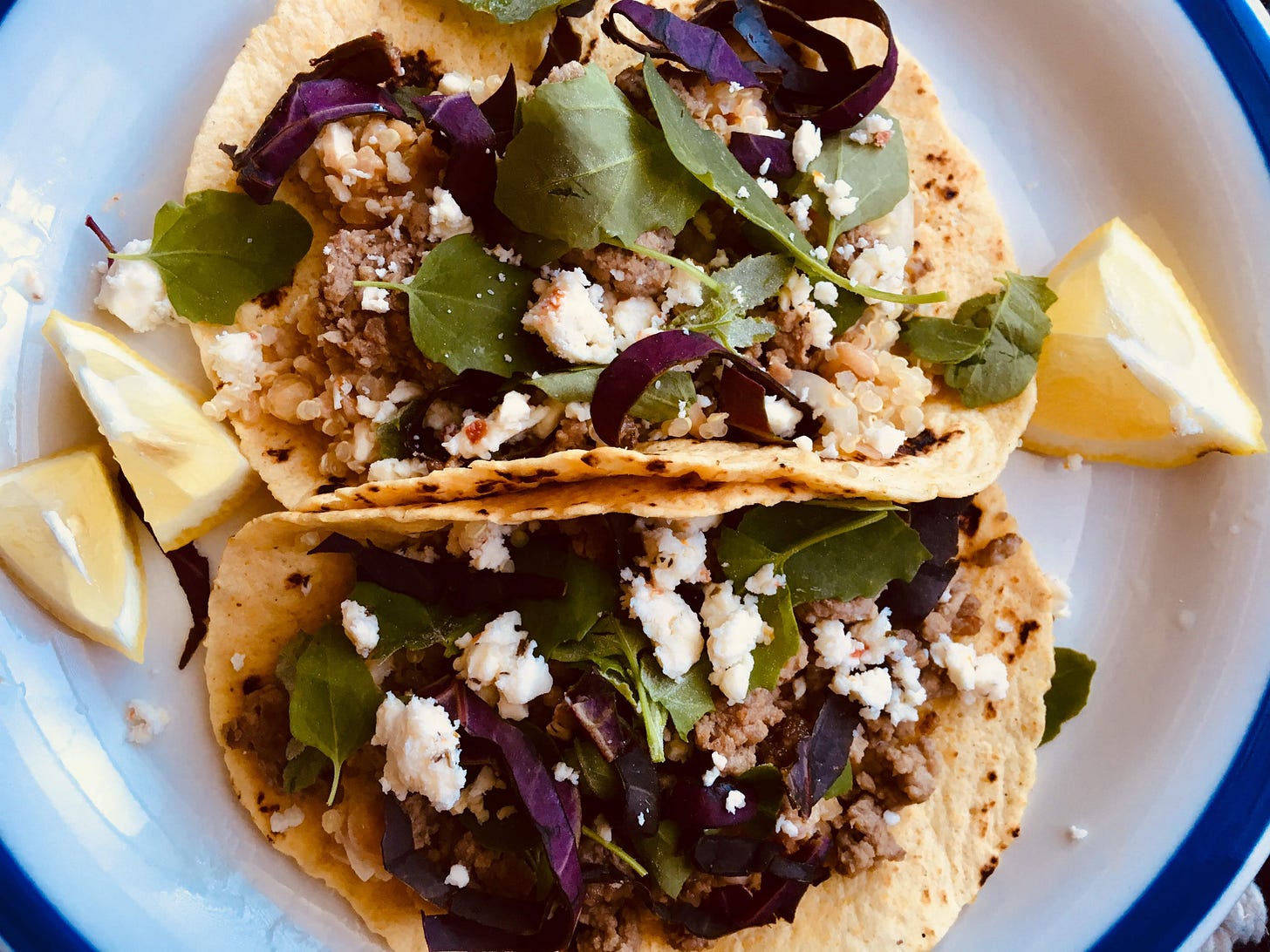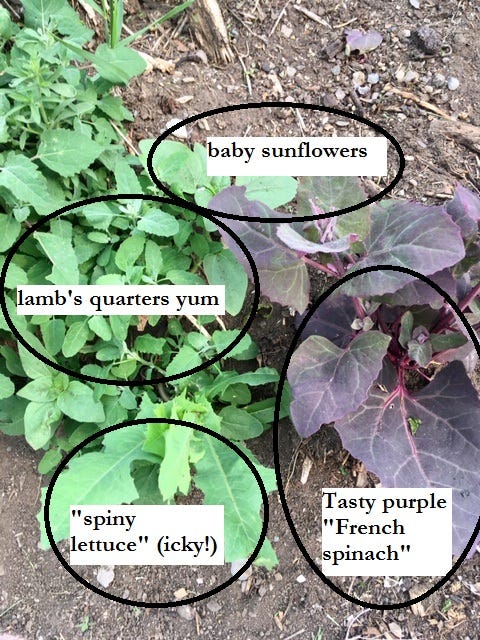Life is short and I hate scrolling through blabber to get to a recipe, so here’s the recipe first, talk after.

“Weed” tacos with lamb and lamb’s quarters
1 lb ground lamb (I find it at Orange Street Food Farm)
1 C. cooked grains of some sort, maybe quinoa or couscous
2-3 small street-style tortillas per person, preferably Trevino’s corn tortillas rule
Toppings: Salt to taste, chopped red onions, crumbled feta, lime wedges, vinegary hot sauce or sweet chili sauce, sprinkle of foraged greens such as lamb’s quarters and red orach
Cook the ground lamb. When lamb is fully cooked, toast the tortillas in a big wide pan, or zap them in a microwave for 20 seconds so they’re pliable. Distribute a few spoonfuls each of lamb and cooked grains onto tortillas. Sprinkle toppings on as you like. Serves two taco lovers.
I’ve been eating weeds a lot lately.
See, I’m excited to eat local plants, and Montana’s growing season is really short. My plants are coming up nicely in my community garden plot, but even the peas and radishes aren’t big enough yet. I just want a bit of something fresh and assertive and green to eat while I wait for the more standard food plants to start partying.
You know what is ready to eat and also growing in abundance? Weeds. A weed is just any plant that you didn’t mean to grow, and many common “weeds” are nutritious and tasty.
I used to think that plants growing outside of a sanctioned garden plot must be icky in some way. At the start of the 2018 growing season at a community garden meeting, one of the other gardeners picked a bunch of the startlingly purple, leafy weeds that grow on the compost piles. He set them out in bunches on a picnic table, inviting people to take some home. I looked askance at the guy and thought he was a weird hippie.
But in midsummer, I realized that spearmint, sunflowers and dill grow like crazy around the community gardens, and who’s ever been hurt by a sunflower? It was fun to pick them for bouquets. I picked and dried some of the spearmint for tea.
Gardening already helped me adjust to the idea that what qualifies as “food” doesn’t have to be wrapped in plastic in an air-conditioned grocery store aisle. Sunflowers and mint eased me into letting go of the notion that plants growing outside of my designated 10x10 patch of dirt must be dangerous. I mean, the weeds live off the same air, dirt and water as the plants inside my little plot boundary. I even picked a leaf off the strange purple weeds, looking around to see if anybody was watching me, and tentatively nibbled on it. It tasted like fresh spinach.
So this spring, with my garden in infancy, I said to hell with it and started to pick a few varieties of fresh wild greens growing out of the garden compost plots. They’re a tasty garnish for my salads and sandwiches, and they grow a few steps from my apartment building.
I think most people know that dandelions are edible, and maybe you’ve heard of dandelion wine. Good Food Store sometimes sells cultivated dandelion greens, if you want to dip your toe in the waters that way. The cultivated dandelion leaves were massive, almost kale-sized, and they were astringent and bitter like radicchio. Tasty stir-fried with sesame oil and chilies and sausage. I find most wild dandelion greens to be kinda gross and raggedy, so I’m not really into them. But young lamb’s quarters, on the other hand, are tender and mild, and tend to be the rock stars of the edible weed world. They grow in abundance and are pretty easy to identify.
I recently learned that the weird purple plants picked by the older gardener guy are probably a variety of red orach, itself a type of amaranth. It goes by many other names, such as French spinach. See? It’s not a weed, just French spinach! Ooh la la! C’est bon! You can buy seeds for red orach and plant it deliberately, even. Red orach grows big tasty leaves with the assertive minerality of good fresh spinach.
Please enjoy this extremely classy illustrated photo of a patch of weeds:

Once the weather heats up, purslane will start snaking its way around the gardens. You’ve undoubtedly seen it. It’s a viney succulent with bright, waxy little leaves that are tangy and savory. (It’s commonly used in Mexican cooking, by the way.)
If you’re not convinced that foraging for wild edibles is fun, and you’re happy to stick with the produce aisle at the grocery store, I absolutely respect that. It’s also really easy for me to differentiate between weeds because I’ve spent a lot of time pulling them. I mercilessly weed my garden plot, because volunteer plants are not invited to party with my intentional plants.
If you are interested in going out and foraging a bit, here are some general rules:
Make sure you’re harvesting from a yard or lawn that isn’t sprayed with chemicals or used as a pet toilet. Carefully identify the plants, and when in doubt, don’t eat it. Do read these tips for identifying lamb’s quarters, which has some funky toxic relatives that you don’t want to mess with. Harvest plants when they’re still quite small, so as to have the best flavor. Pick in the early morning or after a cool, rainy day for the best flavor. Use scissors or a knife to snip off the leaves and a bit of tender stalk; pulling the entire plant will bring up a lot of dirt that’s hard to wash off. Pick just a bit, maybe a handful or two, until you decide what you like.
And once you bring the greens home, dunk them in a water bath two or three times to be really sure they’re cleaned of any soil or grit.
Foraged wild greens go really nicely on tacos, sandwiches, soups and salads - at least until your “real” garden plants come up.
—Kate Whittle


